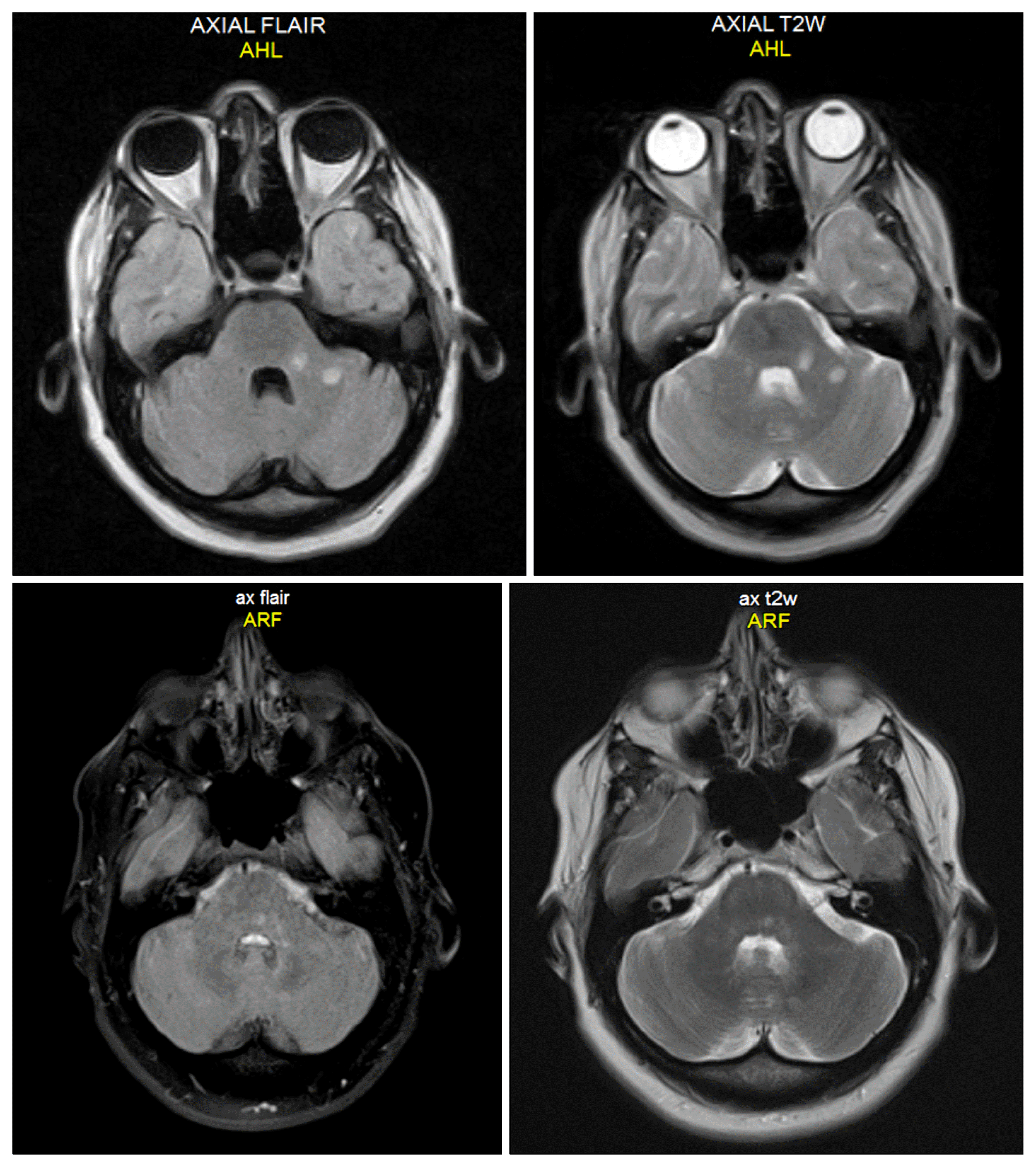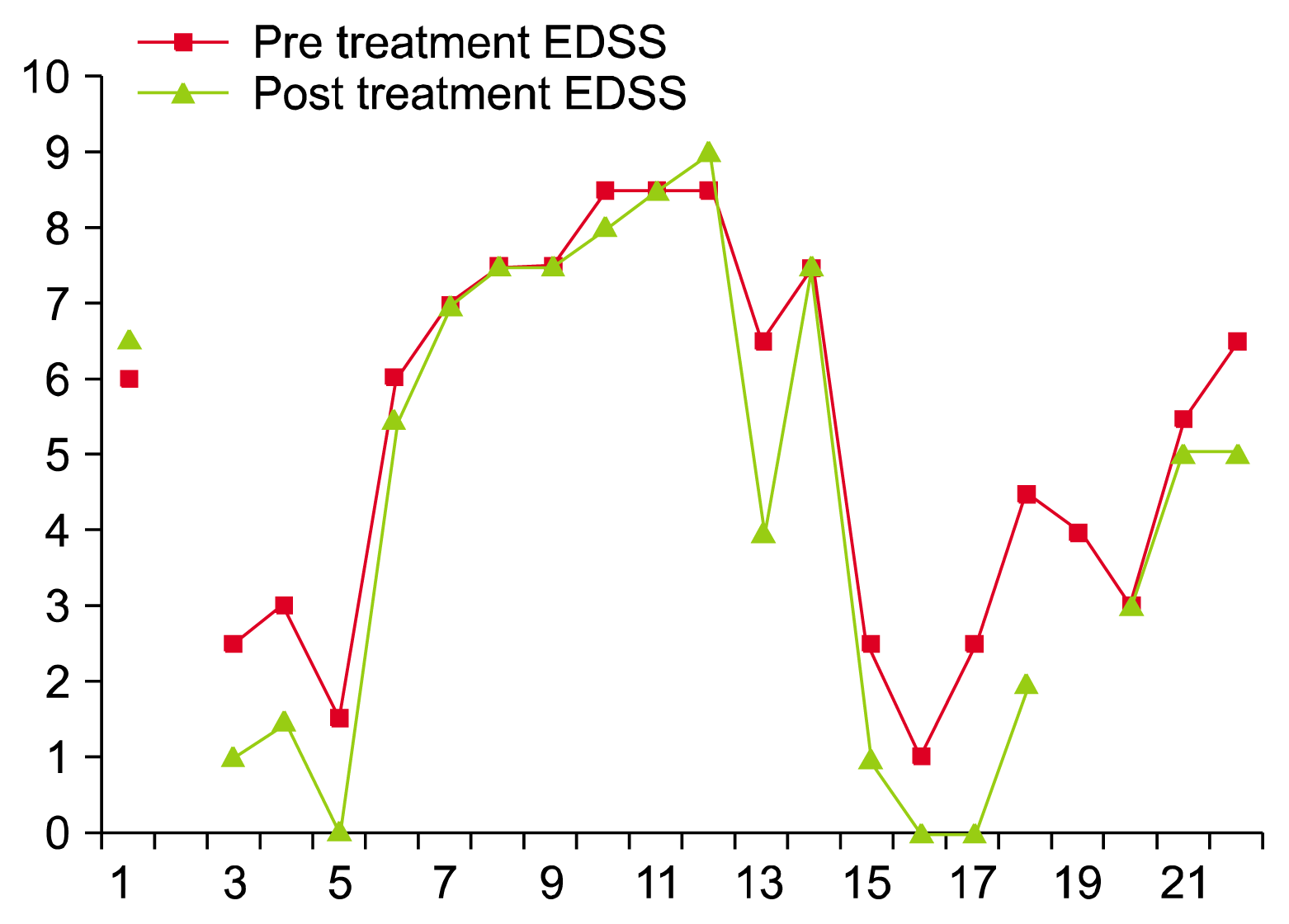3. Barkhof F, Bruck W, De Groot CJ, Bergers E, Hulshof S, Geurts J, Polman CH, van der Valk P. Remyelinated lesions in multiple sclerosis: magnetic resonance image appearance. Arch Neurol. 2003; 60:1073–1081. DOI:
10.1001/archneur.60.8.1073. PMID:
12925362.
6. Chang A, Smith MC, Yin X, Fox RJ, Staugaitis SM, Trapp BD. Neurogenesis in the chronic lesions of multiple sclerosis. Brain. 2008; 131:2366–2375. DOI:
10.1093/brain/awn157. PMID:
18669500. PMCID:
2525445.

7. Calabresi PA. Diagnosis and management of multiple sclerosis. Am Fam Physician. 2004; 70:1935–1944. PMID:
15571060.
8. Lublin FD, Reingold SC. Defining the clinical course of multiple sclerosis: results of an international survey. National multiple sclerosis society (USA) advisory committee on clinical trials of new agents in multiple sclerosis. Neurology. 1996; 46:907–911. DOI:
10.1212/WNL.46.4.907. PMID:
8780061.

9. Franklin RJ, Ffrench-Constant C. Remyelination in the CNS: from biology to therapy. Nat Rev Neurosci. 2008; 9:839–855. DOI:
10.1038/nrn2480. PMID:
18931697.

10. Castro-Borrero W, Graves D, Frohman TC, Flores AB, Hardeman P, Logan D, Orchard M, Greenberg B, Frohman EM. Current and emerging therapies in multiple sclerosis: a systematic review. Ther Adv Neurol Disord. 2012; 5:205–220. DOI:
10.1177/1756285612450936. PMID:
22783370. PMCID:
3388530.

11. CAMMS223 Trial Investigators. Coles AJ, Compston DA, Selmaj KW, Lake SL, Moran S, Margolin DH, Norris K, Tandon PK. Alemtuzumab vs. interferon beta-1a in early multiple sclerosis. N Engl J Med. 2008; 359:1786–1801. DOI:
10.1056/NEJMoa0802670. PMID:
18946064.

13. Corboy JR, Miravalle AA. Emerging therapies for treatment of multiple sclerosis. J Inflamm Res. 2010; 3:53–59. DOI:
10.2147/JIR.S6558. PMID:
22096357. PMCID:
3218736.

14. Lunn JS, Sakowski SA, Federici T, Glass JD, Boulis NM, Feldman EL. Stem cell technology for the study and treatment of motor neuron diseases. Regen Med. 2011; 6:201–213. DOI:
10.2217/rme.11.6. PMID:
21391854. PMCID:
3154698.

15. Dantuma E, Merchant S, Sugaya K. Stem cells for the treatment of neurodegenerative diseases. Stem Cell Res Ther. 2010; 1:37. DOI:
10.1186/scrt37. PMID:
21144012. PMCID:
3025439.

16. Abi Chahine NH, Wehbe TW, Hilal RA, Zoghbi VV, Melki AE, Habib EB. Treatment of cerebral palsy with stem cells: a report of 17 cases. Int J Stem Cells. 2016; 9:90–95. DOI:
10.15283/ijsc.2016.9.1.90. PMID:
27426090. PMCID:
4961108.

18. Abi Chahine NH, Abou Saad ES, Melki SGE. How to maximize the success of stem cell autografts for neuroregeneration. J Stem Cell Res Ther. 2015; 5:271.

19. Sharma A, Gokulchandran N, Chopra G, Kulkarni P, Lohia M, Badhe P, Jacob VC. Administration of autologous bone marrow-derived mononuclear cells in children with incurable neurological disorders and injury is safe and improves their quality of life. Cell Transplant. 2012; 21(Suppl 1):S79–S90. DOI:
10.3727/096368912X633798. PMID:
22507683.

20. Kuban JL, Hecht AB, Onderdonk T, O’Shea MN. Understanding the underlying beneficial biology of stem cells and the development and validation of more relevant animal models is required. Paneth Pediatr Res. 2010; 67:95–101.
21. Payne N, Siatskas C, Barnard A, Bernard CC. The prospect of stem cells as multi-faceted purveyors of immune modulation, repair and regeneration in multiple sclerosis. Curr Stem Cell Res Ther. 2011; 6:50–62. DOI:
10.2174/157488811794480735.

22. Mezey E, Key S, Vogelsang G, Szalayova I, Lange GD, Crain B. Transplanted bone marrow generates new neurons in human brains. Proc Natl Acad Sci. 2003; 100:1364–1369. DOI:
10.1073/pnas.0336479100. PMID:
12538864. PMCID:
298778.

23. Connick P, Kolappan M, Crawley C, Webber DJ, Patani R, Michell AW, Du MQ, Luan SL, Altmann DR, Thompson AJ, Compston A, Scott MA, Miller DH, Chandran S. Autologous mesenchymal stem cells for the treatment of secondary progressive multiple sclerosis: an open-label phase 2a proof-of-concept study. Lancet Neurol. 2012; 11:150–156. DOI:
10.1016/S1474-4422(11)70305-2. PMID:
22236384. PMCID:
3279697.

24. Schäbitz WR, Krüger C, Pitzer C, Weber D, Laage R, Gassler N, Aronowski J, Mier W, Kirsch F, Dittgen T, Bach A, Sommer C, Schneider A. A neuroprotective function for the hematopoietic protein granulocyte-macrophage colony stimulating factor (GMCSF). J Cereb Blood Flow Metab. 2008; 28:29–43. DOI:
10.1038/sj.jcbfm.9600496.

25. Krause DS, Theise ND, Collector MI, Henegariu O, Hwang S, Gardner R, Neutzel S, Sharkis SJ. Multi-organ, multi-lineage engraftment by a single bone marrow-derived stem cell. Cell. 2001; 105:369–377. DOI:
10.1016/S0092-8674(01)00328-2. PMID:
11348593.

26. Purandare C, Shitole DG, Belle V, Kedari A, Bora N, Joshi M. Therapeutic potential of autologous stem cell transplantation for cerebral palsy. Case Rep Transplant. 2012; 825289.

27. Tse HF, Kwong YL, Chan JK, Lo G, Ho CL, Lau CP. Angiogenesis in ischaemic myocardium by intramyocardial autologous bone marrow mononuclear cell implantation. Lancet. 2003; 361:47–49. DOI:
10.1016/S0140-6736(03)12111-3. PMID:
12517468.

28. Nakano-Doi A, Nakagomi T, Fujikawa M, Nakagomi N, Kubo S, Lu S, Yoshikawa H, Soma T, Taguchi A, Matsuyama T. Bone marrow mononuclear cells promote proliferation of endogenous neural stem cells through vascular niches after cerebral infarction. Stem Cells. 2010; 28:1292–1302. PMID:
20517983.

29. Amin AH, Abd Elmageed ZY, Nair D, Partyka MI, Kadowitz PJ, Belmadani S, Matrougui K. Modified multi-potent stromal cells with epidermal growth factor restore vasculogenesis and blood flow in ischemic hind-limb of type II diabetic mice. Lab Invest. 2010; 90:985–996. DOI:
10.1038/labinvest.2010.86. PMID:
20440273. PMCID:
3154725.

30. Mimeault M, Hauke R, Batra SK. Stem cells: a revolution in therapeutics-recent advances in stem cell biology and their therapeutic applications in regenerative medicine and cancer therapies. Clin Pharmacol Ther. 2007; 82:252–264. DOI:
10.1038/sj.clpt.6100301. PMID:
17671448.





 PDF
PDF Citation
Citation Print
Print




 XML Download
XML Download